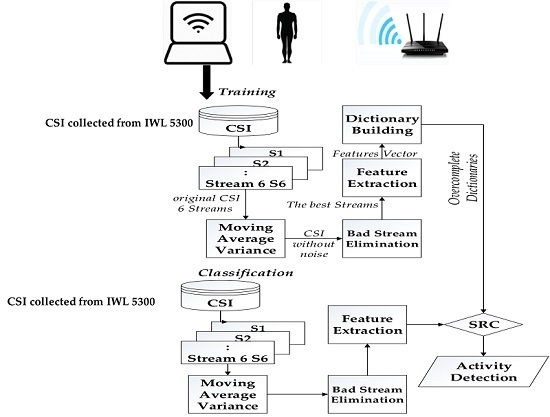Device-Free Indoor Activity Recognition System
Abstract
:1. Introduction
- We present a device-free activity recognition system which enables us to classify several human activities in both LOS and NLOS scenarios.
- We present a pattern segmentation algorithm based on local outlier factor (LOF) to detect the abnormal CSI segments that are caused by human activities; then, we extract useful features from both time domain and frequency domain of raw CSI.
- We adopt sparse representation classification (SRC) algorithm to recognize the proposed activities, and our classification algorithm gains high-accuracy rates in LOS and NLOS.
- We conduct exhaustive experiments with different users that provide us with important insights. Therefore, the system classification ability can be improved by choosing the best parameters gained by experiments.
2. Methodology
2.1. Preprocessing
2.2. Feature Extraction
2.2.1. Pattern Segmentation
2.2.2. Feature Extraction
2.3. Activity Classification
3. Evaluation
3.1. Experiments Setup
3.2. Results
4. Discussion
5. Conclusions
Acknowledgments
Author Contributions
Conflicts of Interest
Abbreviations
| CSI | Channel State Information |
| AP | Access Point |
| DP | Detection Point |
| LOS | Line-of-Sight |
| NLOS | Non-Line-of-Sight |
| RSS | Received Signal Strength |
| OFDM | Orthogonal Frequency-Division Multiplexing |
| LOF | Local Outlier Factor |
| SRC | Sparse Representation Classification |
| TP | True Positive |
| FP | False Positive |
| TN | True Negative |
| FN | False Negative |
References
- Gaglio, S.; Re, G.L.; Morana, M. Human activity recognition process using 3-D posture data. IEEE Trans. Hum. Mach. Syst. 2015, 14, 586–597. [Google Scholar] [CrossRef]
- Field, M.; Stirling, D.; Pan, Z.; Ros, M.; Naghdy, F. Recognizing human motions through mixture modeling of inertial data. Pattern Recognit. 2015, 48, 2394–2406. [Google Scholar] [CrossRef]
- Khan, A.M.; Tufail, A.; Khattak, A.M.; Laine, T.H. Activity recognition on smartphones via sensor-fusion and kda-based svms. Int. J. Distrib. Sens. Netw. 2014, 2014, 1–14. [Google Scholar] [CrossRef]
- Yang, Z.; Zhou, Z.; Liu, Y. From RSSI to CSI: Indoor localization via channel response. ACM Comput. Surv. 2014, 46, 1–33. [Google Scholar] [CrossRef]
- Patwari, N.; Wilson, J. RF sensor networks for device-free localization: Measurements, models, and algorithms. Proc. IEEE 2010, 98, 1961–1973. [Google Scholar] [CrossRef]
- Youssef, M.; Mah, M.; Agrawala, A. Challenges: Device-free passive localization for wireless environments. In Proceedings of the 13th Annual ACM International Conference on Mobile Computing and Networking, Montreal, QC, Canada, 9–14 September 2007; pp. 222–229.
- Xiong, J.; Jamieson, K. ArrayTrack: A fine-grained indoor location system. In Proceedings of the 10th USENIX Symposium on Networked Systems Design and Implementation (NSDI 13), Lombard, IL, USA, 2–5 April 2013; pp. 71–84.
- Zhou, M.; Qiu, F.; Tian, Z.; Wu, H.; Zhang, Q.; He, W. An information-based approach to precision analysis of indoor WLAN localization using location fingerprint. Entropy 2015, 17, 8031–8055. [Google Scholar] [CrossRef]
- Gu, Y.; Quan, L.; Ren, F. Wifi-assisted human activity recognition. In Proceedings of the IEEE Asia Pacific Conference on Wireless and Mobile, Bali, Indonesia, 28–30 August 2014; pp. 60–65.
- Sigg, S.; Shi, S.; Busching, F.; Ji, Y.; Wolf, L. Leveraging RF-channel fluctuation for activity recognition: Active and passive systems, continuous, and rssi–based signal features. In Proceedings of the 11th International Conference on Advances in Mobile Computing & Multimedia (MoMM), ACM, Vienna, Austria, 2–4 December 2013; pp. 43–52.
- Abdelnasser, H.; Youssef, M.; Harras, K.A. Wigest: A ubiquitous wifi-based gesture recognition system. In Proceedings of the IEEE Conference on Computer Communications (INFOCOM), Hong Kong, China, 26 April–1 May 2015; pp. 1472–1480.
- Xiao, J.; Wu, K.; Yi, Y.; Wang, L.; Ni, L.M. Pilot: Passive device-free indoor localization using channel state information. In Proceedings of the IEEE 33rd International Conference on Distributed Computing Systems (ICDCS), Philadelphia, PA, USA, 8–11 July 2013; pp. 236–245.
- Zhang, Z.; Tian, Z.; Zhou, M.; Li, Z.; Wu, Z.; Jin, Y. WIPP: Wi-Fi compass for indoor passive positioning with decimeter accuracy. Appl. Sci. 2016, 6, 108. [Google Scholar] [CrossRef]
- Zhou, Z.; Yang, Z.; Wu, C.; Shangguan, L.; Liu, Y. Omnidirectional coverage for device-free passive human detection. IEEE Trans. Parallel Distrib. Syst. 2013, 25, 1819–1829. [Google Scholar] [CrossRef]
- Qian, K.; Wu, C.; Yang, Z.; Liu, Y.; Zhou, Z. PADS: Passive detection of moving targets with dynamic speed using PHY layer information. In Proceedings of the 20th IEEE International Conference on Parallel and Distributed Systems (ICPADS), Hsinchu, Taiwan, 16–19 December 2014; pp. 1–8.
- Xi, W.; Zhao, J.; Li, X.Y.; Zhao, K.; Tang, S.; Liu, X.; Jiang, Z. Electronic frog eye: Counting crowd using wifi. In Proceedings of IEEE Conference on Computer Communications (INFOCOM), Toronto, ON, Canada, 27 April–2 May 2014; pp. 361–369.
- Wang, Y.; Liu, J.; Chen, Y.; Gruteser, M.; Yang, J.; Liu, H. E-eyes: Device-free location-oriented activity identification using fine-grained wifi signatures. In Proceedings of the 20th Annual International Conference on Mobile Computing and Networking, ACM, Maui, HI, USA, 7–11 September 2014; pp. 617–628.
- Wang, Y.; Jiang, X.; Cao, R.; Wang, X. Robust indoor human activity recognition using wireless signals. Sensors 2015, 15, 17195–17208. [Google Scholar] [CrossRef] [PubMed]
- Al-qaness, M.A.A.; Li, F. WiGeR: WiFi-based gesture recognition system. ISPRS Int. J. Geo-Inf. 2016, 5, 92. [Google Scholar] [CrossRef]
- He, W.; Wu, K.; Zou, Y.; Ming, Z. WiG: WiFi-Based Gesture Recognition System. In Proceedings of the 24th International Conference on Computer Communication and Networks (ICCCN), Las Vegas, NV, USA, 3–6 August 2015; pp. 1–7.
- Halperin, D.; Hu, W.; Sheth, A.; Wetherall, D. Tool release: Gathering 802.11n traces with channel state information. IACM SIGCOM Comput.Commun. Rev. 2011, 41, 53. [Google Scholar] [CrossRef]
- Al-qaness, M.A.A.; Li, F.; Ma, X.; Liu, G. Device-Free Home Intruder Detection and Alarm System Using Wi-Fi Channel State Information. Int. J. Fut. Comput Commun. 2016, 5, 180–186. [Google Scholar] [CrossRef]
- Breunig, M.M.; Kriegel, H.P.; Ng, R.T.; Sander, J. LOF: Dentifying density-based local outliers. ACM Sigmod Rec. 2000, 29, 93–104. [Google Scholar] [CrossRef]
- Wright, J.; Yang, A.Y.; Ganesh, A.; Sastry, S.S.; Ma, Y. Robust face recognition via sparse representation. IEEE Trans. Pattern Anal. Mach. Intell. 2009, 31, 210–227. [Google Scholar] [CrossRef] [PubMed]
- Wei, B.; Hu, W.; Yang, M.; Chou, C.T. Radio-based device-free activity recognition with radio frequency interference. In Proceedings of the 14th International Conference on Information Processing in Sensor Networks (IPSN’15), ACM, Seattle, WA, USA, 14–16 April 2015; pp. 154–165.
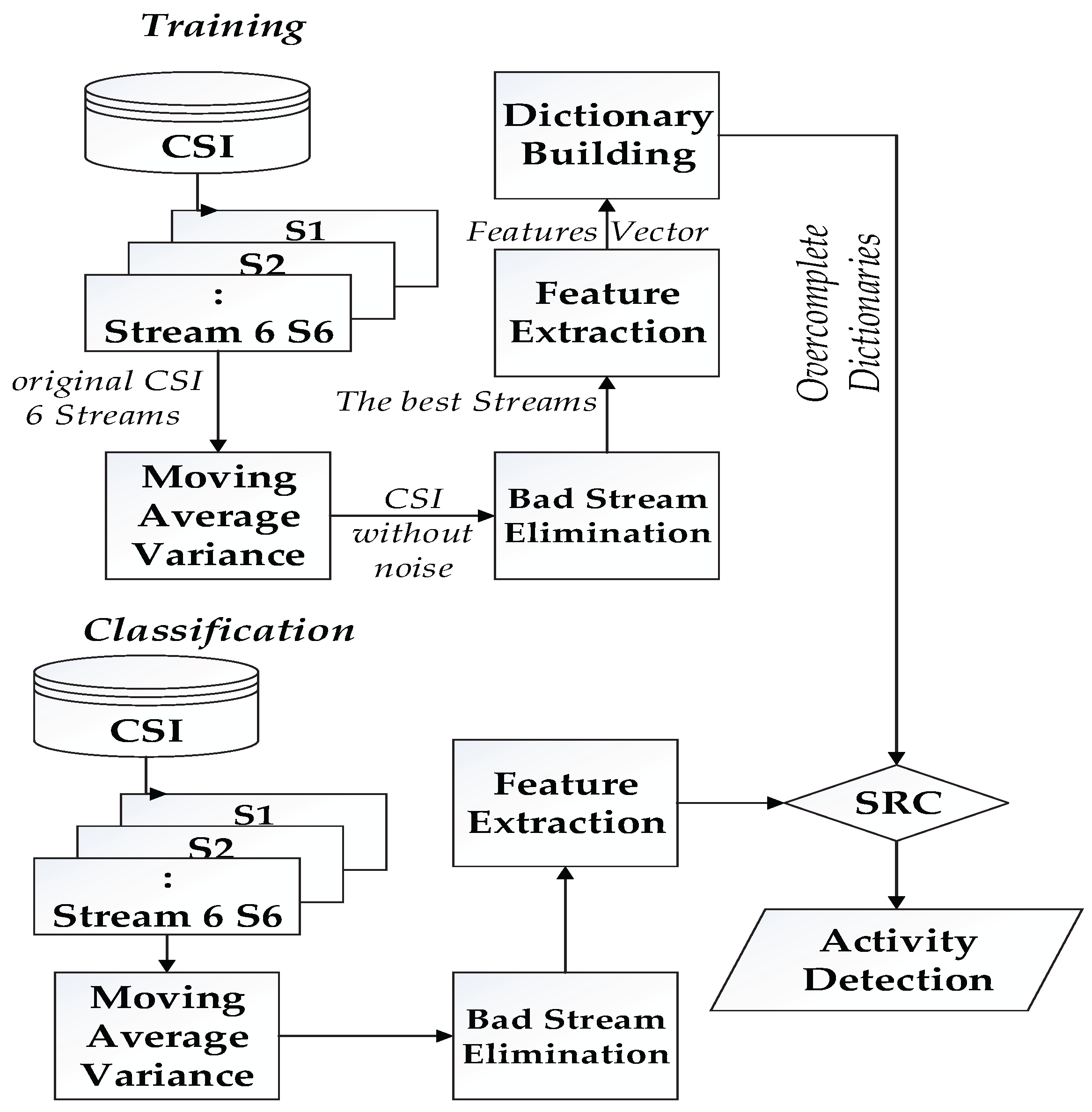
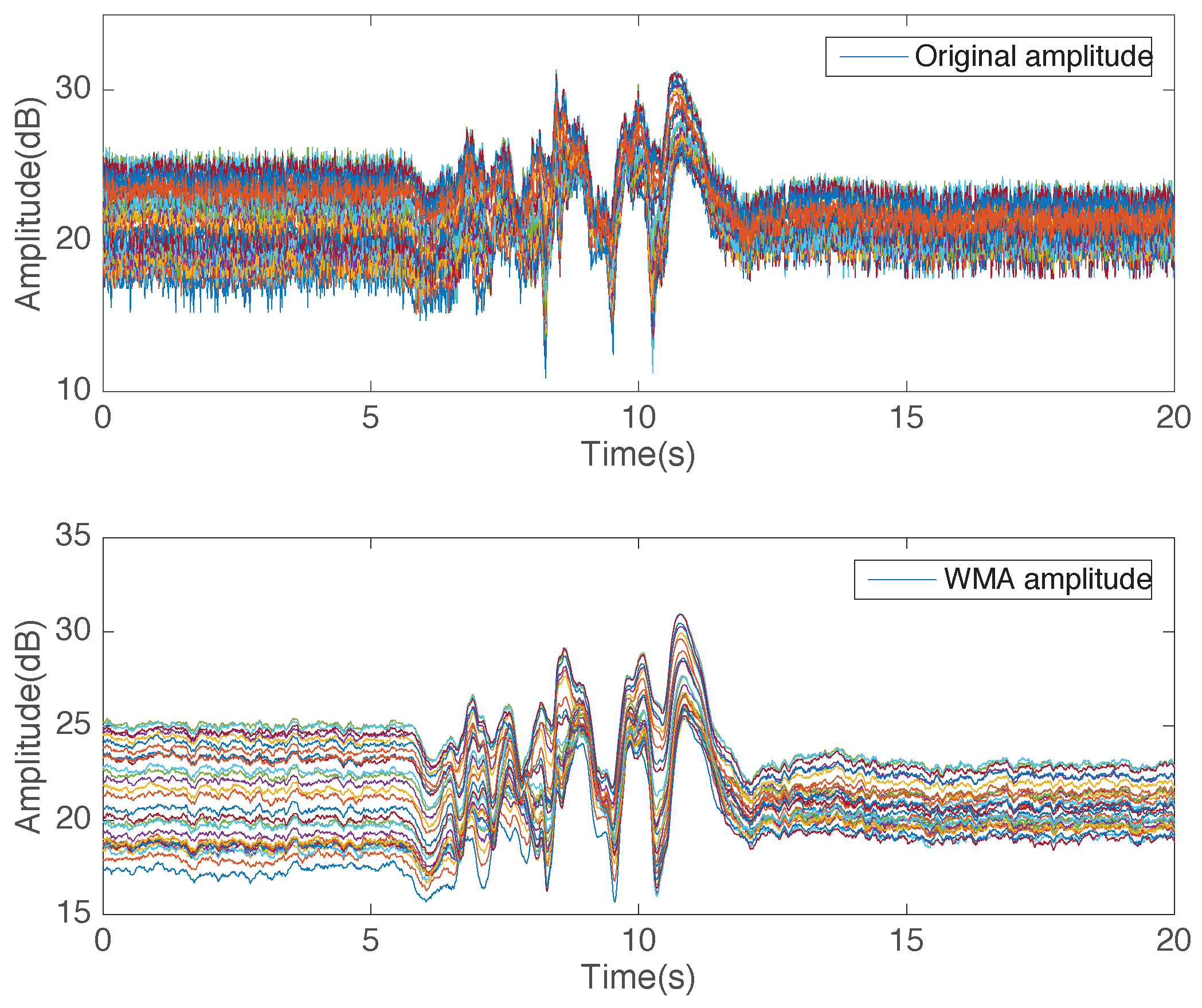
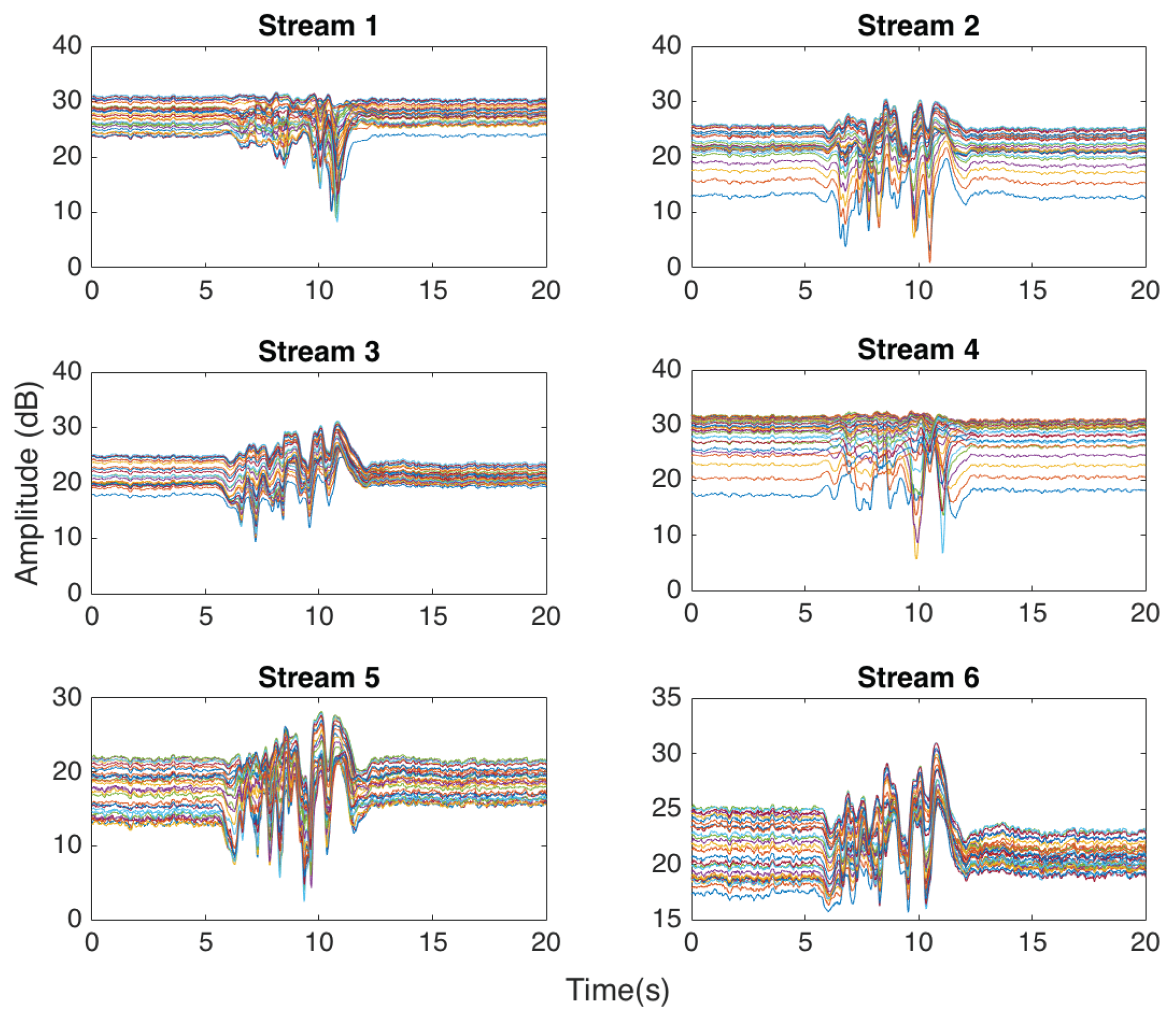
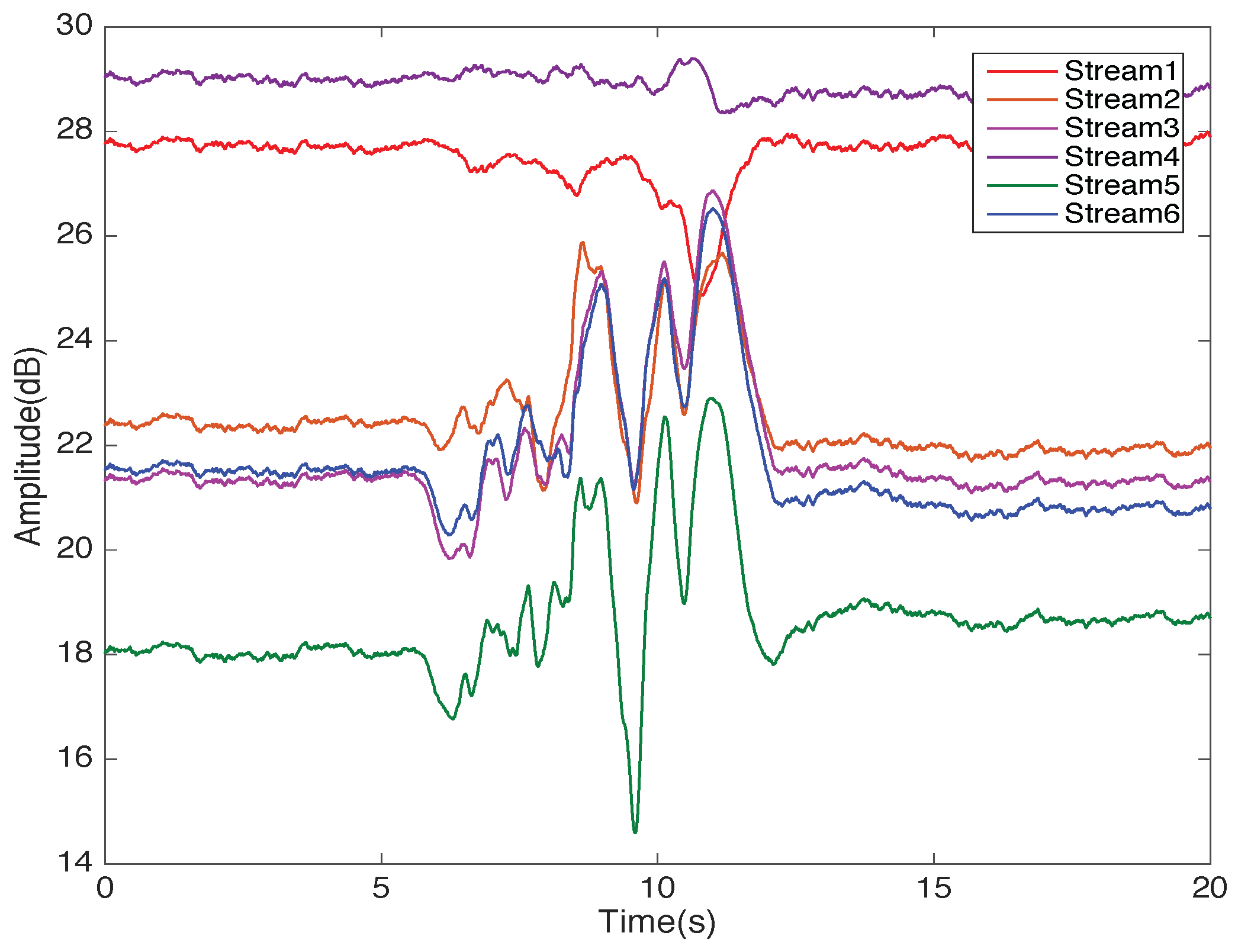
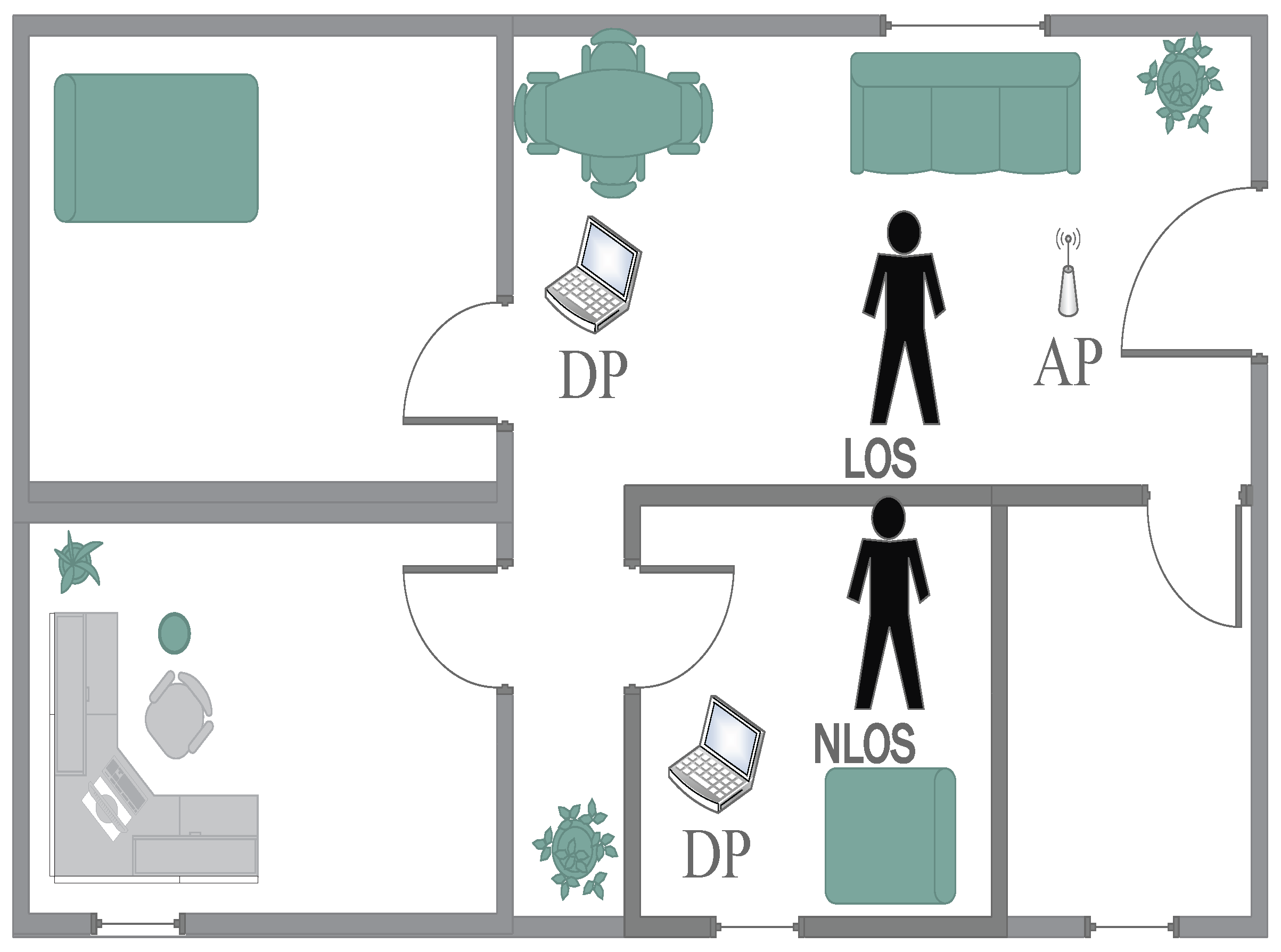
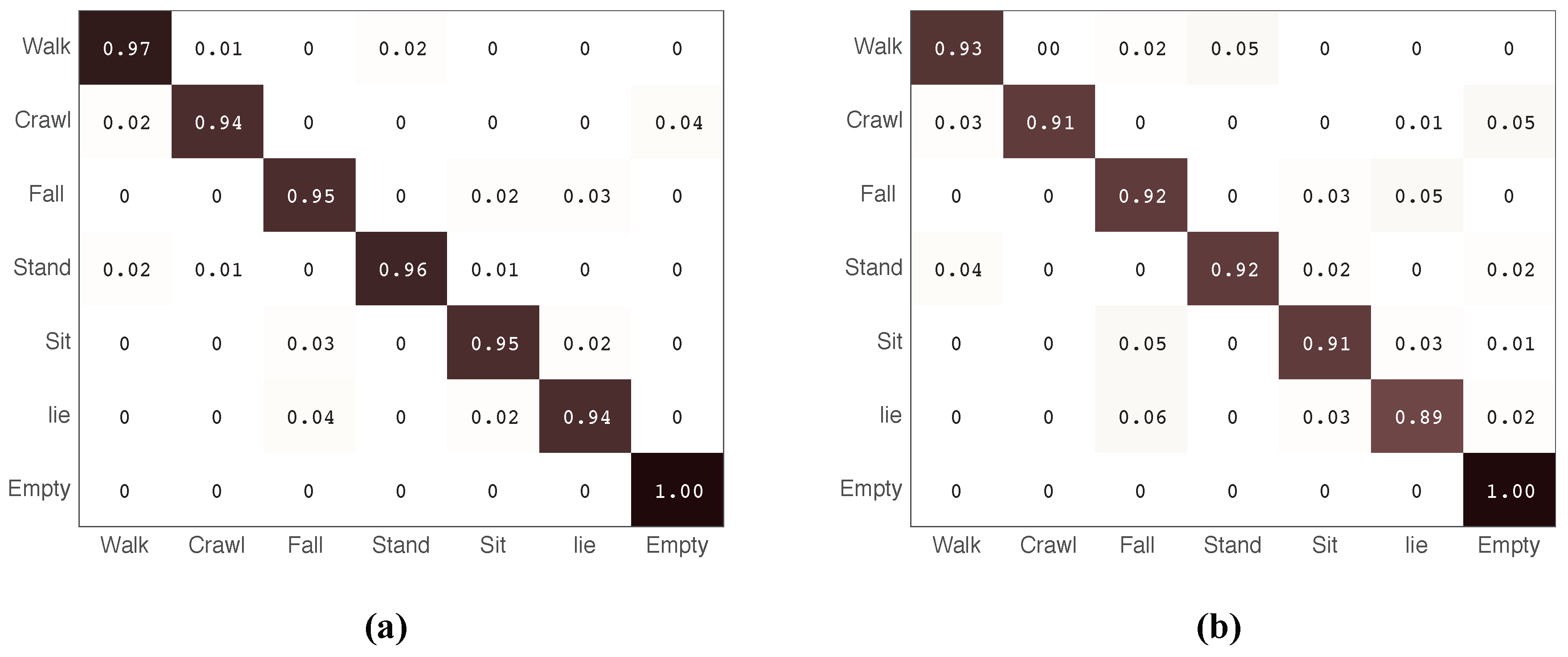
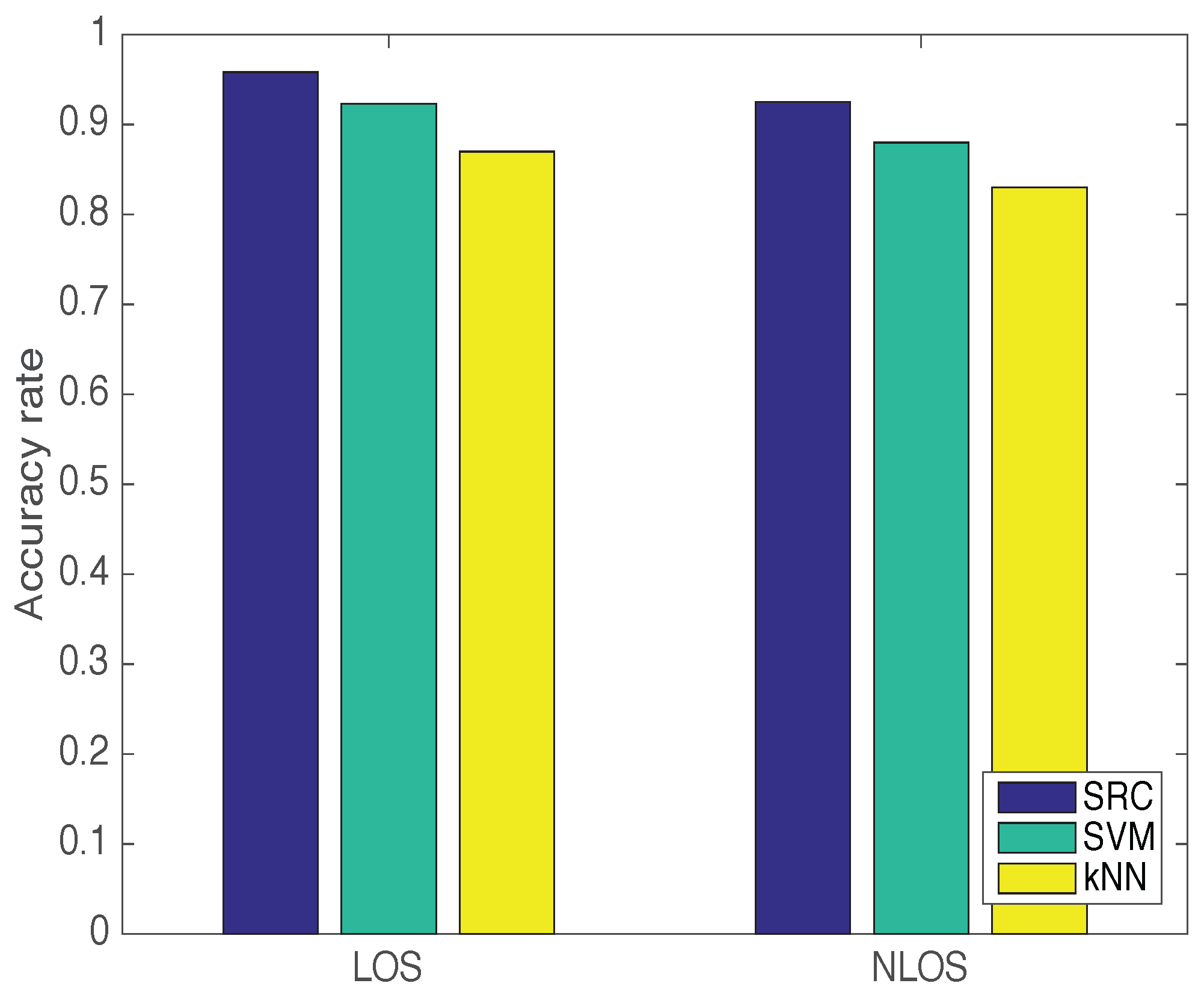
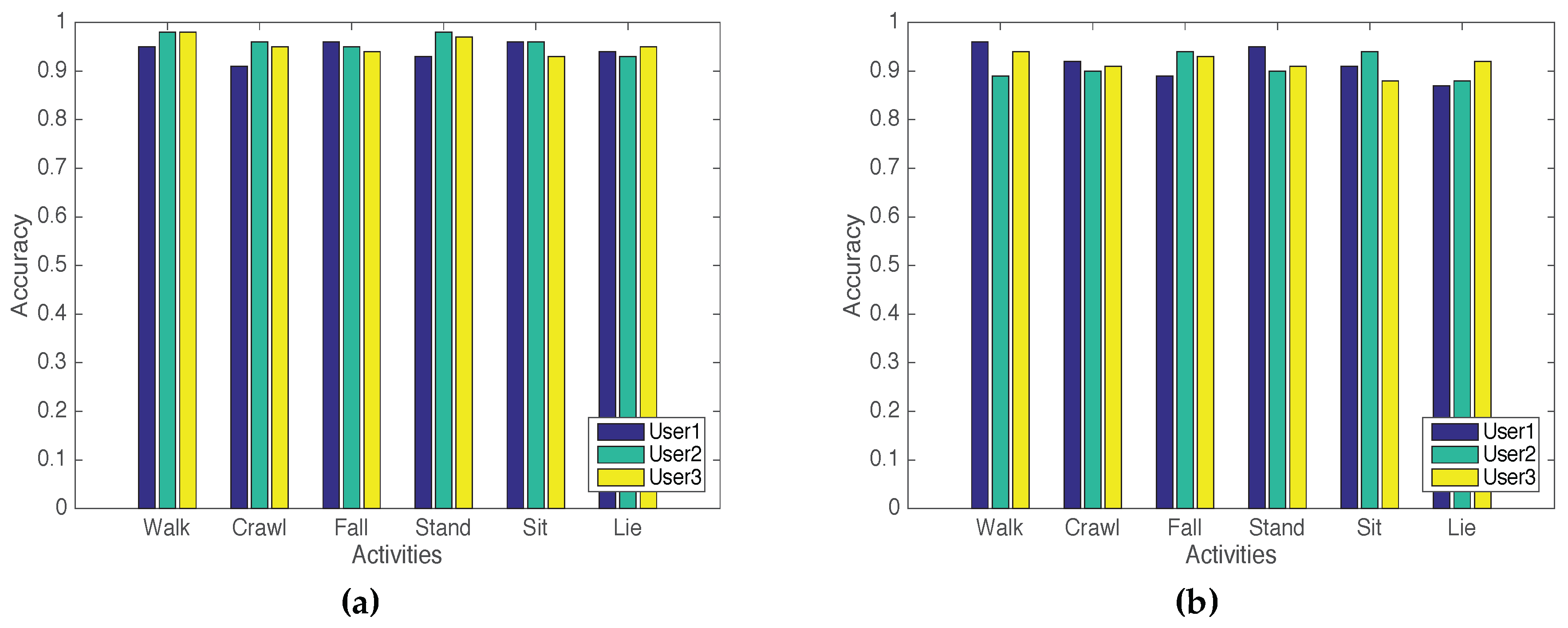
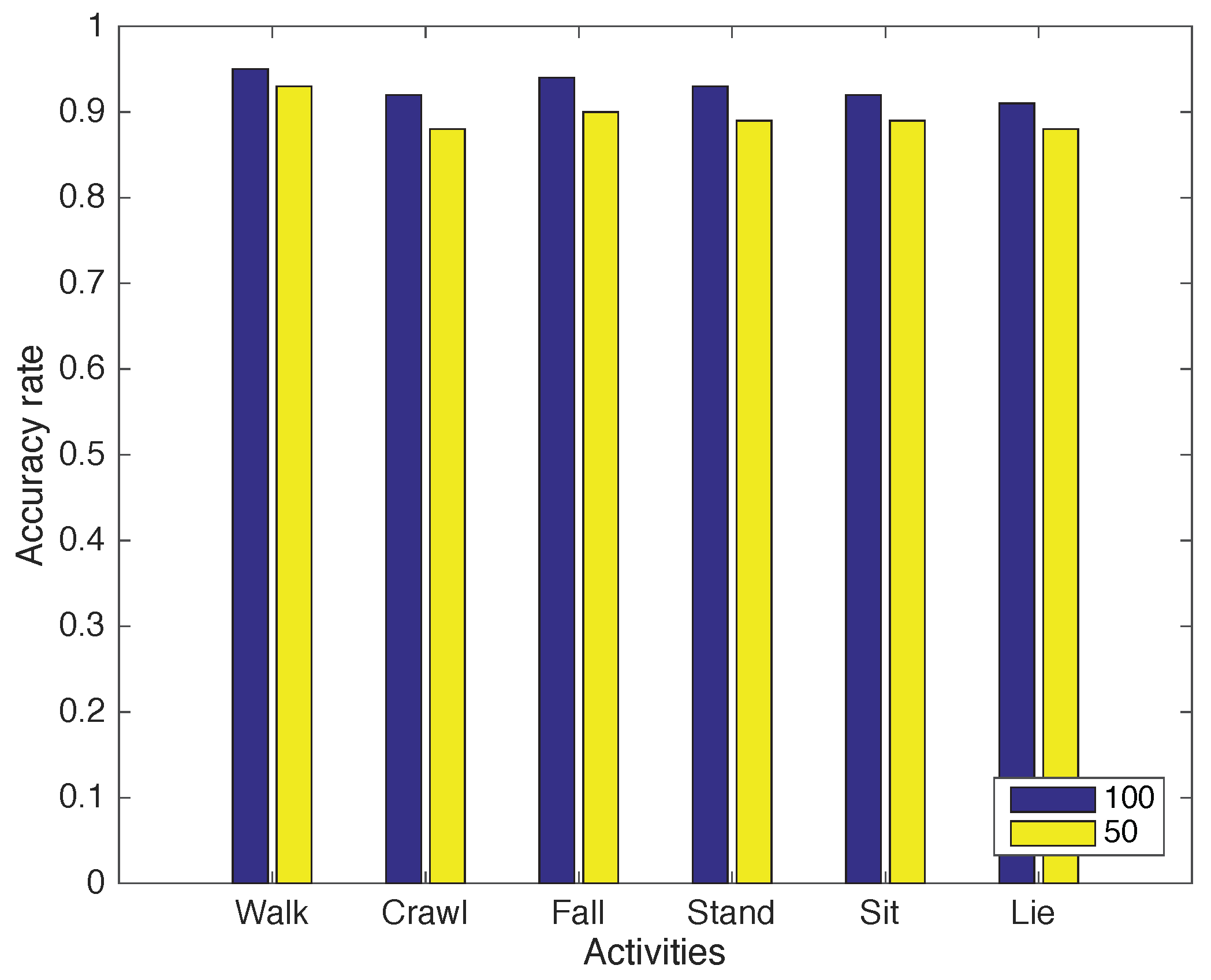
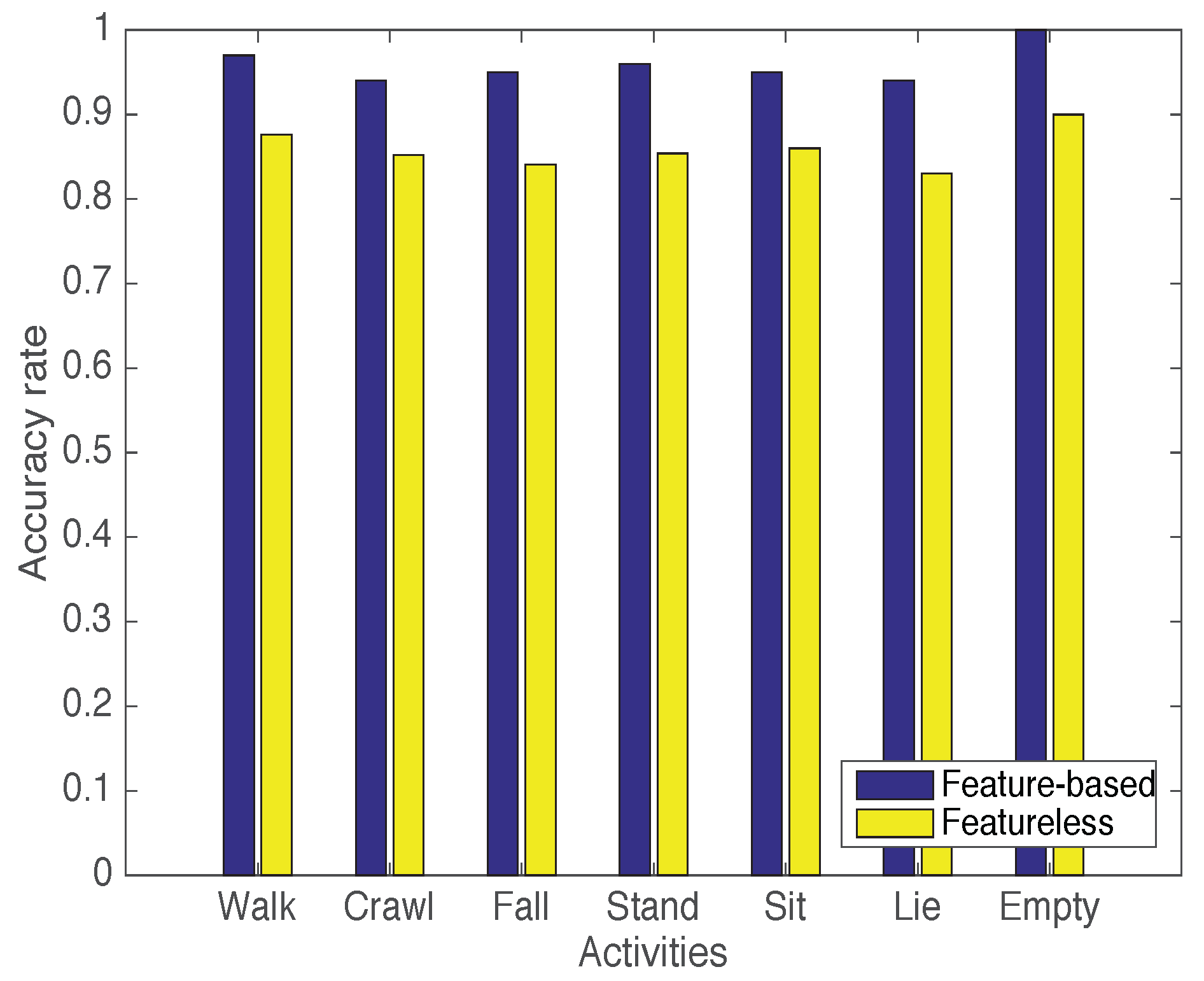
| Activity | Scenario | # of Samples | # of Sessions | # of Users |
|---|---|---|---|---|
| Walk | LOS | 450 | 9 | 3 |
| NLOS | 450 | 9 | 3 | |
| Crawl | LOS | 450 | 9 | 3 |
| NLOS | 450 | 9 | 3 | |
| Fall | LOS | 450 | 9 | 3 |
| NLOS | 450 | 9 | 3 | |
| Stand | LOS | 450 | 9 | 3 |
| NLOS | 450 | 9 | 3 | |
| Sit | LOS | 450 | 9 | 3 |
| NLOS | 450 | 9 | 3 | |
| Lie | LOS | 450 | 9 | 3 |
| NLOS | 450 | 9 | 3 | |
| Empty | LOS | 450 | 9 | 0 |
| NLOS | 450 | 9 | 0 |
© 2016 by the authors; licensee MDPI, Basel, Switzerland. This article is an open access article distributed under the terms and conditions of the Creative Commons Attribution (CC-BY) license (http://creativecommons.org/licenses/by/4.0/).
Share and Cite
Al-qaness, M.A.A.; Li, F.; Ma, X.; Zhang, Y.; Liu, G. Device-Free Indoor Activity Recognition System. Appl. Sci. 2016, 6, 329. https://doi.org/10.3390/app6110329
Al-qaness MAA, Li F, Ma X, Zhang Y, Liu G. Device-Free Indoor Activity Recognition System. Applied Sciences. 2016; 6(11):329. https://doi.org/10.3390/app6110329
Chicago/Turabian StyleAl-qaness, Mohammed Abdulaziz Aide, Fangmin Li, Xiaolin Ma, Yong Zhang, and Guo Liu. 2016. "Device-Free Indoor Activity Recognition System" Applied Sciences 6, no. 11: 329. https://doi.org/10.3390/app6110329
APA StyleAl-qaness, M. A. A., Li, F., Ma, X., Zhang, Y., & Liu, G. (2016). Device-Free Indoor Activity Recognition System. Applied Sciences, 6(11), 329. https://doi.org/10.3390/app6110329






